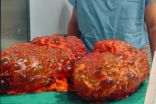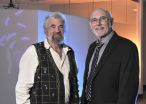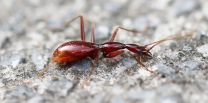Resuscitation science tip sheet
2014-11-15
Abstract 16039/Presentation 1 (Lakeside Hall D1, Cross Core)
American Heart Association pre-arrival telephone CPR guidelines help save lives
Implementing American Heart Association pre-arrival telephone CPR guidelines throughout Arizona has dramatically increased the number of bystanders performing CPR and survival from cardiac arrest, according to research presented at the American Heart Association's Scientific Sessions 2014.
The guidelines call for emergency dispatchers and call takers to provide assertive step-by-step Telephone-CPR instructions to bystanders during ...
ASN Kidney Week late-breaking clinical studies highlight advances in kidney care
2014-11-15
Philadelphia, PA (November 15, 2014) -- The results of numerous high-impact clinical trials that could affect kidney-related medical care will be presented at ASN Kidney Week 2014, November 11-16 at the Pennsylvania Convention Center in Philadelphia, PA.
Among the studies are the following (presented in numerical order):
SA-PO1092 A Randomized Multicomponent Intervention to Reduce Disparities in Transplant Referral: Interim Results from the RaDIANT Community Study -- Rachel E. Patzer, Leighann Sauls, Jennifer C. Gander, M. Ahinee Amamoo, Laura Plantinga, Debra D. Evans, ...
High impact clinical trials yield results that could lead to improved kidney care
2014-11-15
Philadelphia, PA (November 15, 2014) -- The results of numerous high-impact clinical trials that could affect kidney-related medical care will be presented at ASN Kidney Week 2014, November 11-16 at the Pennsylvania Convention Center in Philadelphia, PA.
A trial of 156 patients who developed acute kidney injury (AKI) following cardiac surgery found that treatment with certain stem cells did not shorten the time it took patients to achieve complete kidney recovery, nor did it decrease their risk of dying prematurely or needing dialysis. Unfortunately, "AKI is common condition ...
Two drugs are no more effective than 1 to treat common kidney disease
2014-11-15
Using two drugs was no more effective than a single drug in slowing disease progression in people with autosomal dominant polycystic kidney disease (ADPKD), according to two studies funded by the National Institutes of Health (NIH). One of the studies also showed that rigorous blood pressure treatment slowed growth of kidney cysts, a marker of ADPKD, but had little effect on kidney function compared to standard blood pressure treatment.
The results of the HALT-PKD Clinical Trials Network studies will be published online November 15 in two papers in the New England Journal ...
Aspirin or blood pressure medication before and after surgery does not reduce risk of AKI
2014-11-15
In patients undergoing noncardiac surgery, neither aspirin nor clonidine (a medication primarily used to treat high blood pressure) taken before and after surgery reduced the risk of acute kidney injury, according to a study appearing in JAMA. The study is being released to coincide with its presentation at the American Society of Nephrology's annual Kidney Week meeting.
About 10 percent of the 200 million adults estimated to undergo major noncardiac surgery each year develop acute kidney injury (a sudden loss of kidney function). Perioperative (around the time of surgery) ...
Use of antibiotic following kidney transplantation does not prevent virus infection
2014-11-15
Among kidney transplant recipients, a 3-month course of the antibiotic levofloxacin following transplantation did not prevent the major complication known as BK virus from appearing in the urine. The intervention was associated with an increased risk of adverse events such as bacterial resistance, according to a study appearing in JAMA. The study is being released to coincide with its presentation at the American Society of Nephrology's annual Kidney Week meeting.
Kidney transplantation is the preferred treatment for end­stage renal disease. The development of potent ...
Study finds weight loss of 10 percent or more in seniors significantly raises hip fracture risk
2014-11-15
Taipei, November 15, 2014 - While a low body mass index (BMI) of less than 20 kg/m2 has been shown to be an independent risk factor for hip fractures, far less is known about the relationship of body weight changes on hip fracture risk.
The findings of a new study presented today at the IOF Regionals Asia-Pacific Osteoporosis Meeting in Taipei, show that among middle-aged to elderly Singapore Chinese, weight loss of 10% or more was associated with a 56% higher hip fracture risk.
The researchers used data from the Singapore Chinese Health Study, a population-based cohort ...
Osteoporotic fractures cost China's healthcare system close to 10 billion USD annually
2014-11-15
Taipei, November 15, 2014 - An epidemiological study presented today at the 5th Asia-Pacific Osteoporosis Meeting is one of the first to project the immense and growing economic cost of osteoporotic fractures in China.
The study, by investigators from the University of Tasmania, Anhui Medical University and Nanjing Medical University, used decision analytic modelling to estimate the burden of osteoporotic fractures. The researchers estimated that in 2010 more than 2.3 million osteoporosis-related hip, clinical vertebral and wrist fractures occurred in the population ...
Scientists uncover mechanism that controls the fitness of cells, impacting aging and disease
2014-11-15
DALLAS - November 15, 2014 - A novel looping mechanism that involves the end caps of DNA may help explain the aging of cells and how they initiate and transmit disease, according to new research from UT Southwestern Medical Center cell biologists.
The UT Southwestern team found that the length of the endcaps of DNA, called telomeres, form loops that determine whether certain genes are turned off when young and become activated later in life, thereby contributing to aging and disease.
"Our results suggest a potential novel mechanism for how the length of telomeres may ...
Weight-loss surgery may improve kidney function
2014-11-14
Philadelphia, PA (November 14, 2014) -- In addition to helping patients shed pounds, weight loss surgery may also improve kidney function, according to a study that will be presented at ASN Kidney Week 2014 November 11¬-16 at the Pennsylvania Convention Center in Philadelphia, PA.
Weight loss, or bariatric, surgery is highly effective for rapid weight loss in patients with morbid obesity, who are at markedly increased risk for kidney failure. Because the effect of bariatric surgery-induced weight loss on kidney function is unknown, Alex Chang, MD (Geisinger Medical ...
Most adults can't donate kidneys due to preventable health issues, possible loss of income
2014-11-14
Philadelphia, PA (November 14, 2014) -- The majority of individuals in the United States are not eligible to donate a kidney, even if they wanted to, according to a study that will be presented at ASN Kidney Week 2014 November 11¬-16 at the Pennsylvania Convention Center in Philadelphia, PA.
There is a shortage of living kidney donors in the United States, but no one has previously examined the general population to see who would be eligible to be donors. To assess the potential US donor pool, researchers led by Anthony Bleyer, MD (Wake Forest Baptist Medical Center) ...
Exercise provides clear benefits for patients with chronic kidney disease
2014-11-14
Philadelphia, PA (November 14, 2014) -- Simple exercises can help improve the health of patients with kidney disease, according to studies that will be presented at ASN Kidney Week 2014 November 11¬-16 at the Pennsylvania Convention Center in Philadelphia, PA.
Heart disease is the leading cause of death in patients with chronic kidney disease (CKD). Because exercise capacity is significantly reduced in CKD patients, Sharlene Greenwood, MD (King's College Hospital, in London) and her colleagues examined the effect of 12 months of exercise training on kidney function ...
Teens with earlier school start times have higher crash rates
2014-11-14
DARIEN, IL - A new study suggests that teen drivers who start class earlier in the morning are involved in significantly more motor vehicle accidents than peers with a later high school start time. The results underscore the importance of the "Awake at the Wheel" campaign of the National Healthy Sleep Awareness Project.
Results show that the weekday crash rate for teen drivers during the 2009 to 2010 school year was about 29 percent higher in Chesterfield County, Va., where high school classes began at 7:20 a.m., than in adjacent Henrico County, Va., where classes started ...
Genetic testing for personalized nutrition leads to better outcomes
2014-11-14
VIDEO:
What is Nutrigenomix? Here's a primer.
Click here for more information.
Researchers from the University of Toronto (U of T) report that personalized dietary advice based on a person's genetic makeup improves eating habits compared to current "one-size-fits-all" dietary recommendations. The findings were published online today in the journal PLoS One.
"We conducted the first randomized controlled trial to determine the impact of disclosing DNA-based dietary advice on ...
New special report highlights NSF-funded broader impacts
2014-11-14
Each year, the National Science Foundation (NSF) receives about 50,000 proposals for research funding in all fields of science and engineering from all corners of the country. NSF distinguishes among the proposals through a competitive review process built on two criteria: intellectual merit and broader impacts--will the research advance knowledge and will it benefit society?
Today, NSF released a special report to showcase broader impacts and examples of the diverse and far-reaching ways NSF-supported science touches our lives.
"Intellectual merit and broader impacts ...
Do spinal cord injuries cause subsequent brain damage?
2014-11-14
Baltimore, Md., November 14, 2014--Most research on spinal cord injuries has focused on effects due to spinal cord damage and scientists have neglected the effects on brain function. University of Maryland School of Medicine (UM SOM) researchers have found for the first time that spinal cord injuries (SCI) can cause widespread and sustained brain inflammation that leads to progressive loss of nerve cells, with associated cognitive problems and depression.
The research, published recently in two articles, one in of the Journal of Neuroscience, the other in Cell Cycle, ...
Ears and hearing effects continue to reverberate after Boston Marathon bombing
2014-11-14
Boston (Nov. 14, 2014) - After two bombs exploded near the finish line of the Boston Marathon on April 15, 2013, acute trauma to the ears - such as ruptured eardrums - was immediately apparent to those caring for the victims. However, the full extent of the effect on the ears and hearing of victims was not fully recognized for weeks. In the end, more than 100 patients were evaluated for blast-related otologic injuries.
Almost immediately, Boston researchers set out to detail the types of otologic injury and report on the outcomes of patients undergoing otologic treatment. ...
Rocky Mountain storms lead to new findings about hailstones
2014-11-14
BOZEMAN, Mont. - Hailstones from three Rocky Mountain storms formed around biological material, then bounced around the clouds picking up layers of ice, according to a new Montana State University study.
The discovery of a biological embryo extends previous findings about the formation of snow and rain, applies to hailstones globally and provides basic information about a little-studied topic, said the researchers who published their findings Nov. 6 in the Journal of Geophysical Research: Atmospheres.
"This is the first paper to really show that biological material ...
Cutting-edge computer software helps pinpoint aggressiveness of breast cancer tumors
2014-11-14
Researchers at Western University are using cutting-edge genetic mutation-analysis software developed in their lab to interpret mutations in tumour genome that may provide insight into determining which breast cancer tumours are more likely spread to other parts of the body and which ones won't.
Their findings are published today in the journal, Nature Scientific Reports.
"We are using a unique software program in our lab that looks at a type of mutation called a splicing mutation that is typically overlooked using current methods," said lead author on the study, Stephanie ...
New imaging technique identifies receptors for targeted cancer therapy
2014-11-14
Dartmouth researchers have developed a fluorescence imaging technique that can more accurately identify receptors for targeted cancer therapies without a tissue biopsy. They report on their findings in "Quantitative in vivo immunohistochemistry of epidermal growth factor receptor using a receptor concentration imaging approach," which was recently published in Cancer Research.
"Protein overexpression is a hallmark of certain cancers and is used in clinical oncology to personalize treatment through tumor detection, molecular therapies, and therapeutic monitoring," said ...
What's the current role of liver biopsy in children? Position paper in Journal of Pediatric Gastroenterology and Nutrition
2014-11-14
November 14, 2014 - While noninvasive alternatives are increasingly available, liver biopsy still provides essential information in some children with liver disease, according to a new position paper in the Journal of Pediatric Gastroenterology and Nutrition, official journal of the European Society for Paediatric Gastroenterology, Hepatology and Nutrition (ESPGHAN) and the North American Society for Pediatric Gastroenterology, Hepatology and Nutrition. The journal is published by Lippincott Williams & Wilkins, a part of Wolters Kluwer Health.
The position paper was ...
Geographer highlights postcode lottery over diabetes and obesity risk
2014-11-14
'We are now living in a world of ubiquitous location: from sat-navs to GPS enabled tablets and smartphones, our everyday activities leave digital and spatially located footprints. This presents tremendous opportunities for explicitly geographical analyses of all kinds of data.'
-Professor Lex Comber, University of Leicester
The work of geographers at the University of Leicester has helped to identify a postcode lottery that increases your risk of developing diabetes or obesity. This and other aspects of how geography can advance our understanding of society will form ...
Recommendation theory
2014-11-14
Devavrat Shah's group at MIT's Laboratory for Information and Decision Systems (LIDS) specializes in analyzing how social networks process information. In 2012, the group demonstrated algorithms that could predict what topics would trend on Twitter up to five hours in advance; this year, they used the same framework to predict fluctuations in the prices of the online currency known as Bitcoin.
Next month, at the Conference on Neural Information Processing Systems, they'll present a paper that applies their model to the recommendation engines that are familiar from websites ...
A kingdom of cave beetles found in Southern China
2014-11-14
A team of scientists specializing in cave biodiversity from the South China Agricultural University (Guangzhou) unearthed a treasure trove of rare blind cave beetles. The description of seven new species of underground Trechinae beetles, published in the open access journal ZooKeys, attests for the Du'an karst as the most diverse area for these cave dwellers in China.
"China is becoming more and more fascinating for those who study cave biodiversity, because it holds some of the most morphologically adapted cavernicolous animals in the world. This is specifically true ...
Chemical in coffee may help prevent obesity-related disease
2014-11-14
Athens, Ga. - Researchers at the University of Georgia have discovered that a chemical compound commonly found in coffee may help prevent some of the damaging effects of obesity.
In a paper published recently in Pharmaceutical Research, scientists found that chlorogenic acid, or CGA, significantly reduced insulin resistance and accumulation of fat in the livers of mice who were fed a high-fat diet.
"Previous studies have shown that coffee consumption may lower the risk for chronic diseases like Type 2 diabetes and cardiovascular disease," said Yongjie Ma, a postdoctoral ...
[1] ... [3061]
[3062]
[3063]
[3064]
[3065]
[3066]
[3067]
[3068]
3069
[3070]
[3071]
[3072]
[3073]
[3074]
[3075]
[3076]
[3077]
... [8690]
Press-News.org - Free Press Release Distribution service.




